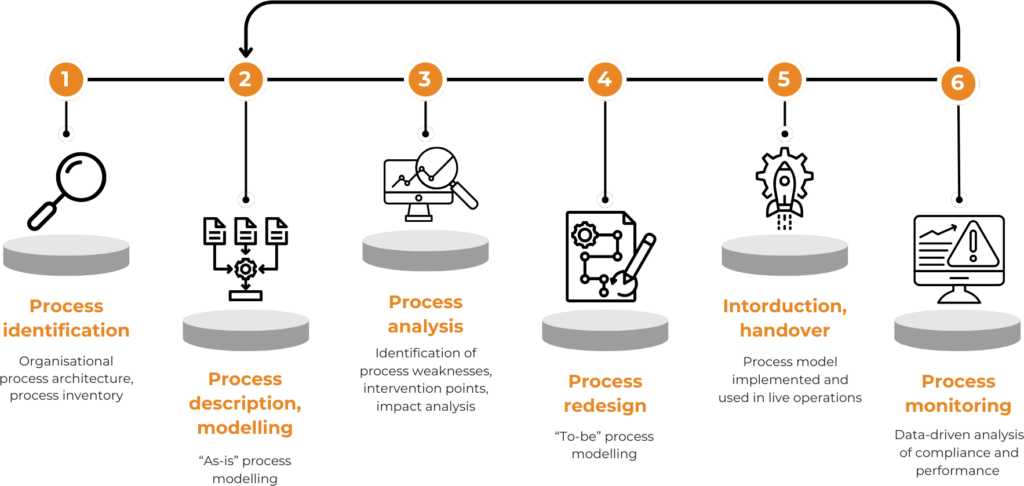ORGANIZATIONAL PROCESS MANAGEMENT DEVELOPMENT
We solve complex problems in organizational processes
With our process management consulting services, we help organizations increase their operational efficiency by simplifying and automating their business processes.
Business Process Management (BPM) is designed to support rapid organizational change. It is an approach to building intuitive, data-driven, flexible and adaptive organizations, turning processes from a simple chain of activities into a key driver of organizational value creation.
The theme could cover a wide range of development opportunities and improvements:
- Development of an organization-level process inventory (architecture, process landscape), Value Stream Mapping
- Process modelling, mapping, development of process documentation
- Process analysis and development of proposals for transformation, improvement, intervention and support for implementation
- Establishing process roles and responsibilities, clarifying and developing handover points
- Design and implementation of new organizational processes
- Process automation preparation and automation solutions
- Establish an organizational "Business Process Management Office" (BPMO) with responsibilities and operational frameworks
What happens after contacting us?
The continuous involvement of key stakeholders is critical to the success of the development of organizational processes or organizational process capabilities, so we strive to ensure that development is driven by the needs of senior and functional managers, with the continuous involvement of key stakeholders during implementation.
1. Free consultation: understanding needs, goals, options
2. Quick survey, root cause exploration
3. Senior management presentation, setting realistic targets
4. Proposed timetable and preparation of the offer
5. Contracting
6. Providing our expertise within the commonly agreed framework
Our Featured Experts

Domonkos Végh

Zsolt Czimbalmos

Orsolya Szenkovits-Varró

Fanni Leila Varga

New Year's Eve track

Dóra Szabó
HOW DO WE SUPPORT ORGANIZATIONAL PROCESS IMPROVEMENT?
According to our professional concept, process maturity improvements can be divided into 6 separate sections, illustrated in the schematic below. A certain number of stages are cyclical, not a one-off exercise,but a necessary skill to be mastered by the organization. An important part of our concept is to equip the supported organisations to perform the steps below independently, thus supporting the retention of organizational skills and knowledge.

About the 6 stages

1. identification
Creating an organizational process inventory, prioritizing processes
Objective: Identifying and inventorying our organizational processes, prioritising processes, highlighting the processes that have the most impact on the business (separation of core, management and supporting processes)
Phase Outputs:
- Process inventory and organizational-level process architecture (also known as process landscape or process hierarchy)
- Categorized core processes, management processes and supporting processes
- Definition of needs and expectations for handover points among departments
- Selected and prioritized core processes for the next stage

2. modelling
Mapping and modelling core processes, documentation of core processes in their current state
Objective: Mapping (modelling) the highlighted core processes into detailed process maps, flowcharts and creation of the initial version of the process description documents (PDDs). The aim of this stage is to gain a deep understanding of the structure, logic and flow of the current core business processes.
Phase Outputs:
- Review of available information
- Documentation and modelling of processes in their current state
- Prioritized core processes for analysis and development

3. analysis
Identification of intervention points for selected processes
Goal: Detailed analysis of the selected and prioritized core processes, identification of potential intervention points to improve process efficiency, effectiveness and performance.
Phase Outputs:
- Suggested intervention points for process improvement and reengineering
- Creation of action plans regarding process development, identification of initial intervention points

4. REDESIGN
Redesign processes to their new, optimized state
Objective: Implementing the redesign of existing processes using the results of the analysis, and/or creating of brand new business processes.
Outcome products
- Revised, optimized processes adopted, finalized documentation
- Finalization of implementation action plans, identification of responsibilities, tasks and deadlines to be met
.

5. Introduction
Introduction of redesigned processes, handover for operation
Objective: Implement and integrate the redesigned and approved processes into daily operations, ensuring their efficiency and effectiveness.
Phase Outputs:
- Prepared education and training materials for the new processes
- Identified process performance indicators (KPIs)
- Prepared documentation and tools for monitoring and evaluation of processes in the first post-implementation period

6. Supervision
Monitoring and fine-tuning the processes put in place
Objective: We will continue to evaluate and fine-tune the effectiveness of the new processes post-implementation, monitor the impact of the implementation and respond to any problems or needs for adjustment.
Phase Outputs:
- Gather feedback and fine-tuning suggestions on the processes put in place
- Suggestions for further fine-tuning of processes
- Process performance indicators evaluated

1. identification
Creating an organizational process inventory, prioritizing processes
Objective: Identifying and inventorying our organizational processes, prioritising processes, highlighting the processes that have the most impact on the business (separation of core, management and supporting processes)
Phase Outputs:
- Process inventory and organizational-level process architecture (also known as process landscape or process hierarchy)
- Categorized core processes, management processes and supporting processes
- Definition of needs and expectations for handover points among departments
- Selected and prioritized core processes for the next stage

2. modelling
Mapping and modelling core processes, documentation of core processes in their current state
Objective: Mapping (modelling) the highlighted core processes into detailed process maps, flowcharts and creation of the initial version of the process description documents (PDDs). The aim of this stage is to gain a deep understanding of the structure, logic and flow of the current core business processes.
Phase Outputs:
- Review of available information
- Documentation and modelling of processes in their current state
- Prioritized core processes for analysis and development

3. analysis
Identification of intervention points for selected processes
Goal: Detailed analysis of the selected and prioritized core processes, identification of potential intervention points to improve process efficiency, effectiveness and performance.
Phase Outputs:
- Suggested intervention points for process improvement and reengineering
- Creation of action plans regarding process development, identification of initial intervention points

4. REDESIGN
Redesign processes to their new, optimized state
Objective: Implementing the redesign of existing processes using the results of the analysis, and/or creating of brand new business processes.
Outcome products
- Revised, optimized processes adopted, finalized documentation
- Finalization of implementation action plans, identification of responsibilities, tasks and deadlines to be met
.

5. Introduction
Introduction of redesigned processes, handover for operation
Objective: Implement and integrate the redesigned and approved processes into daily operations, ensuring their efficiency and effectiveness.
Phase Outputs:
- Prepared education and training materials for the new processes
- Identified process performance indicators (KPIs)
- Prepared documentation and tools for monitoring and evaluation of processes in the first post-implementation period

6. Supervision
Monitoring and fine-tuning the processes put in place
Objective: We will continue to evaluate and fine-tune the effectiveness of the new processes post-implementation, monitor the impact of the implementation and respond to any problems or needs for adjustment.
Phase Outputs:
- Gather feedback and fine-tuning suggestions on the processes put in place
- Suggestions for further fine-tuning of processes
- Process performance indicators evaluated
Introducing the BPMO-concept
Business Process Managemet Offices (aka. BPMO) can perform a number of key tasks to improve an organization's processes and their performance. Process improvements never end with only the optimization and re-thinking of business processes. Over time, even the most accurately modelled and operated processes need to be reengineered. It makes sense to entrust the tasks involved to a dedicated department, namely the BPMO.

Possible tasks for the BPMO
- Creates and maintains the organizational process architecture
- Organize the organizational processes into a consistent structure
- Implement strategic objectives at process level
- Maintenance and scheduled review of key processes
- Identify and prioritize process improvement projects
- Gathering information on processes to improve
- Setting process improvement priorities in the light of the strategy
- Manages the process performance measurement system
- Collect daily, weekly, monthly and annual process performance data
- Collecting information on process performance at organizational level
- Compiling process performance reports
- Operates the process owner system
- Training of new colleagues, training of existing process owners
- Caring for the community of process owners
- BPM toolkit development
- Ensuring the availability of various BPM tools and standards
- Purchase of new BPM tools
- Risk and compliance management
- Translation of external requirements into process documentation
- Compilation and maintenance of documents e.g. for ISO 9001 audit
Process improvements that can be achieved
Transparency
- It becomes clear who is doing what in the organization and when these tasks can be completed
- Understand why certain tasks and processes take longer than ideal
- Intervention points for critical situations become clear
Integration
- Formulation and standardization of needs and expectations related to handover points among departments
- Integration of process serving systems, including robotic process automation (RPA)
- Extracting and using data from current systems
Upgrade
- Embed workflows into systems without affecting the actual workflow and productivity
- Central management of team tasks and workflows
Process efficiency
- Quick identification of barriers and areas for improvement
- Control and correction in case of inefficiencies
- Transparent indicators and dashboards for managers
- Standardized transactions, runs, and procedures

